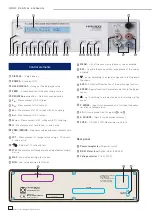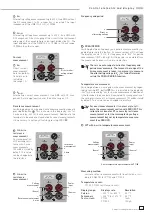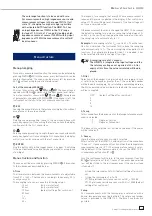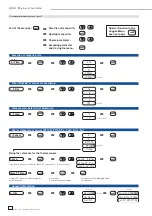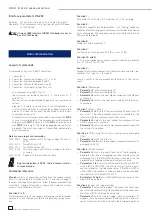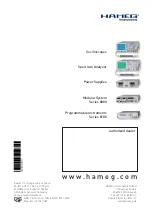
51
Subject to change without notice
will not cause any storage of results either in the buffer or
in the results memory.
Function 7
(Zero) activates zero adjustment.
– Parameter
1
causes the next result to be taken as zero
reference and to be stored in the E2PROM non-volatile
memory.
Function 8
(Result) defi nes the format of the results.
– Parameters 4 and 5
alternate between degrees C and F in
the temperature measurement modes.
Function 9
(Storage) controls the results memory. Single
trigger (0161) or buffer (01A1) modes will not affect the
memory. The results memory may be written to and read
independently.
– Parameter 0
stops the storage of results.
– Parameter 1
starts the storage. Locations are used starting
from 1 always using the next free one up to a maximum of
15. The memory header contains the function, the range,
and the measurement time.
– Parameter
2
causes the transmission of all results con-
tained in a memory which fi rst must be selected by the
command 01BX. This transmission will not be interrupted
by any new results. If a memory shall be read several times
it has to be selected each time by the command 01BX.
– Parameter 3
will cause transmission of the next result
(starting with the fi rst one) of a memory which fi rst must
be selected by the command 01BX. This command allows
to control the speed of result transmission.
– Parameter
4
will erase the complete result memory.
– Parameters 5 to 7
are status informations. 0195 signals the
end of result transmission from a memory. 0196 signals
that a memory selected by 01BX is empty. 0197 signals that
either all 32,000 locations or all 15 records are occupied.
Function A
(Buffer) controls the result buffer. Results will not
any more be transmitted automatically, instead they are
stored in a ring buffer which holds the last 15 results. Un-
less the results are fetched by the commands 01A2 or 01A3
the oldest result will be overwritten. In case the autostatus
function is selected the transmission of status information
will be inhibited, this information will be lost (see commands
02C4 and 02C5). Without a command from the controlling
unit the instrument will not transmit any information.
– Parameter
0
turns the buffer off.
– Parameter
1
turns the buffer on.
– Parameter
2
will cause transmission of all results in the
buffer.After the last result was sent the message 01A6
(buffer empty) will be transmitted.
– Parameter 3
issues the oldest result in the buffer memo-
ry. After transmission of the last result the message 01A6
(buffer empty) will be transmitted.
– Parameter 4
erases the buffer. This is necessary after any
change of function or range as it is no longer possible to
identify function or/and range of each result. The same holds
for other changes of parameters like measurement time,
fi lter etc.
– Parameter 5
will erase the buffer automatically after any
command of group 0 and the commands 0108 or 0109. The
command 01A4 will disable this function.
– Paraneter 6
will inform that the buffer is empty.
Function B
(record no.)
– Parameters
1
to F select a result memory which then may
be read by Storage Dump (0192) or Storage Single Dump
(0193). The function 01BX will send an information about
the header of the memory selected using the form 0XX for
function and range and 011X for the measurement time. In
case a memory selected is empty 0196 will be transmitted.
The instrument will automatically number the memories
starting with 1.
Function C
(Temp Comp) defi nes the reference compensation
method in case of temperature measurement with ther-
mocouples.
– Parameter 0
compensates for the reference joint at 0 de-
grees C.
– Parameter 1
(23 degr. C) assumes a reference joint tem-
perature of 23 degr. C.
– Parameter 2
(FRONT) takes the last temperature mea-
surement result from a PT100 or PT1000 measurement
(2- or 4-wire) and uses it for compensation. When using a
2-wire-sensor a PT sensor and a thermocouple may be
connected simultaneously thus allowing switching back
and forth.
Function F
(Test):
– Parameter
1
causes a RAM test which does not destroy any
data. The test result will be transmitted either with 01F4
(RAM GOOD) or 01F5 (RAM FAIL).
Group 2
selects the interface modes and diverse information.
Using a IEEE interface (HO880) the baud rate has to be set to
9600 baud.
Function 2
(Com) will be stored in the E2PROM (default value
9600).
– Parameter 0
turns transmission off.
– Parameter 3
selects 9600 Baud and turns the transmission
on.
– Parameter
4
selects 19200 Baud and turns the trans-missi-
on on. This baud rate is mandatory for 10 ms measurement
time and transmission.
Function C
(Message) delivers instrument status information.
– Parameter
2
will transmit the complete instrument status.
In turn information of groups 0 and 11 to 15 will be trans-
mitted. The status informations 0197, 0198, and 01A6 will
be transmitted if they were activated. The command 02C2
will cause the transmission of the following informations:
Answers:
PARAMETER:
00XX
Measurement
functions
0-6, 9
Ranges and sensors
010X
Autoranging
0,1 Off
or
On
011X Measurement time
1-7
10 ms to 60 s
012X Filter length
0-4
Off, 2 to 16
014X Math program
0-3, 7, 8 Off, Offset, High
Limit, Low Limit,
Max,
Min.
016X Trigger mode
0,1
single or auto
018X Temp. Selection
4,5
degree C or F
019X Results memory
0,1
Off or On
019X Results memory
7
Full
019X Results memory
8
Single result storage
01AX Results buffer
0,1
Off or On
01AX Results buffer
5
Autoclear selected
01CX Temp. compensation 0,1,2
External, 23 degr. C,
PT
temperature
measurement
– Parameter 3
disables the auto status function (02D4) and
the continuous status function (02D5).
– Parameter
4
turns the auto status function (02D4) on. The
continuous status function (02D5) will be disabled if active.
If commands are sent via the interface all commands of
groups 0 and 1 will be echoed immediately, asynchronously
to the measurements. If commands are received which are
D a t a C o m m u n i c a t i o n




